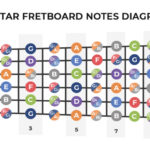Welcome back to our exploration of guitar chords! If you’ve already explored the elegant Cmaj7 chord, prepare to enrich your harmonic palette further. In this lesson, we’re diving into the captivating world of the Cmaj9 Guitar Chord. This extended chord adds a beautiful, airy quality to your playing, making it a favorite in genres like jazz and beyond.
Let’s break down how to construct this rich chord. As you may know, a Cmaj7 chord is built from a C major triad (C-E-G) with the addition of the major seventh (B). You can see this construction in Example 1. To transform it into a Cmaj9 guitar chord, we simply add the major ninth interval, which is D. Think of it as adding the note D, which is the same as the second note in the C major scale, on top of the Cmaj7 (Example 2). The addition of this ninth creates a noticeable difference in the chord’s character, adding a layer of sophistication and openness. You’ll often find the major ninth chord gracing the soundscapes of jazz music, where its extended harmony shines.
Example 3 demonstrates how to transition from a common open position Cmaj7 to a Cmaj9. Many of these shapes also allow you to incorporate the open high E string for added resonance. Example 4 takes the same concept and applies it to barre chord shapes, giving you movable Cmaj9 voicings up the neck. Remember, in these barre chord forms, including the high E string is optional. For even higher voicings, explore Examples 5 and 6. Notice in Example 5 you can add texture by using the open high E string, and in Example 6, you can use both the open high E and B strings. Finally, Example 7 presents a voicing where the third of the chord, E, becomes the bass note, offering a different flavor.
By now, you should have a solid grasp of how to create various voicings for the Cmaj9 guitar chord starting from Cmaj7 shapes. To hear the Cmaj9 in a popular song context, listen to Radiohead’s iconic track “Creep.” It beautifully features the lushness of this chord. Keep practicing these shapes, and stay tuned for our next lesson, where we’ll explore another essential chord: the minor seventh.
“
Example 1: Visual representation of the Cmaj7 chord structure on a guitar fretboard, illustrating the notes C, E, G, and B.
“
Example 2: Diagram showing the Cmaj9 chord on the guitar, built by adding the note D (the ninth) to the Cmaj7 chord.
“
Example 3: Open position Cmaj9 guitar chord shape, demonstrating a common and accessible voicing for beginners.
“
Example 4: Barre chord variations for Cmaj9, providing movable shapes for playing the chord in different positions on the neck.
“
Example 5: A higher position voicing of the Cmaj9 chord on the guitar, expanding the tonal possibilities.
“
Example 6: Another higher voicing for Cmaj9, showcasing different fingerings and sonic textures further up the fretboard.
“
Example 7: Cmaj9 voicing with E as the bass note, offering an inverted version of the chord for a unique harmonic color.

